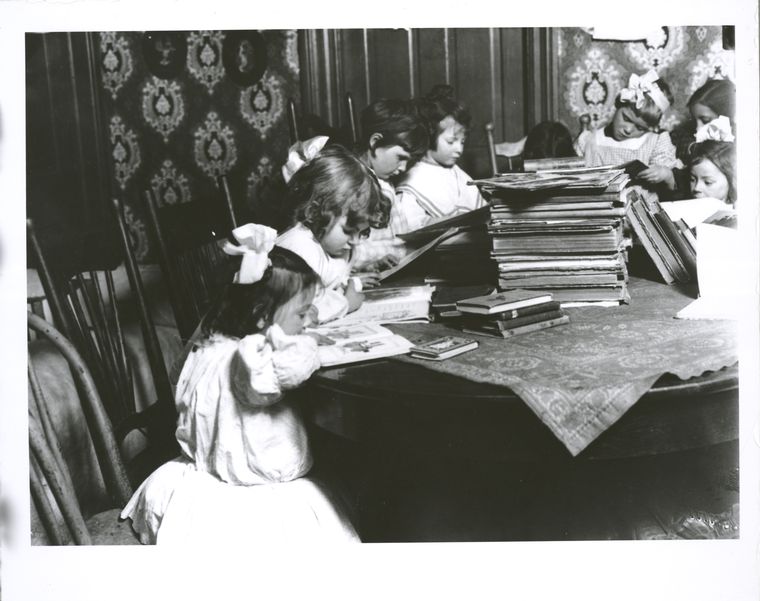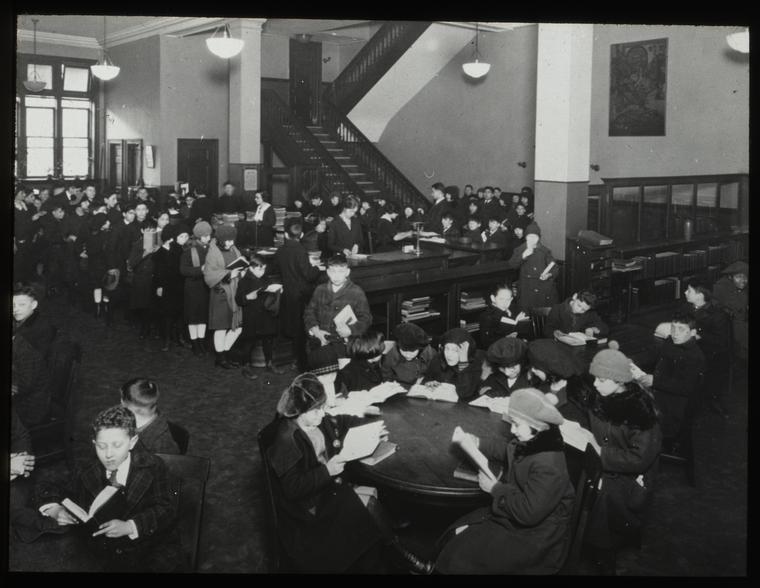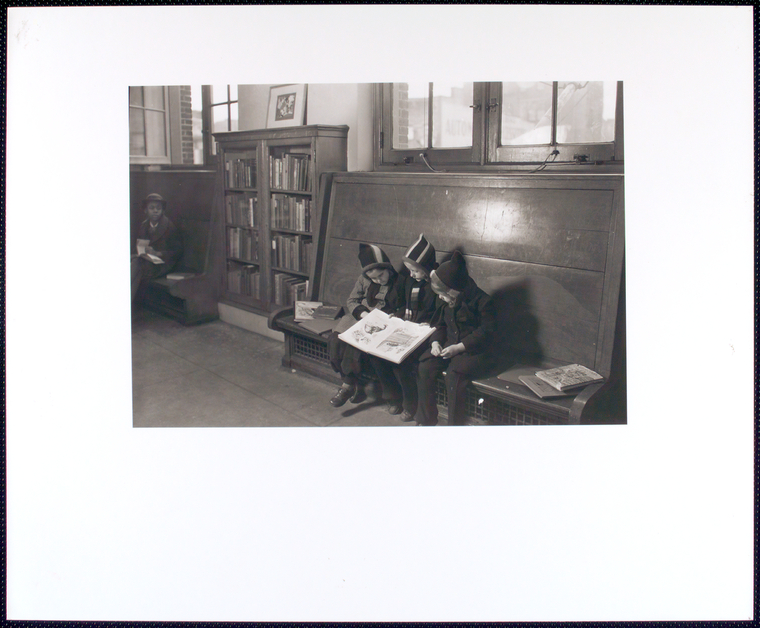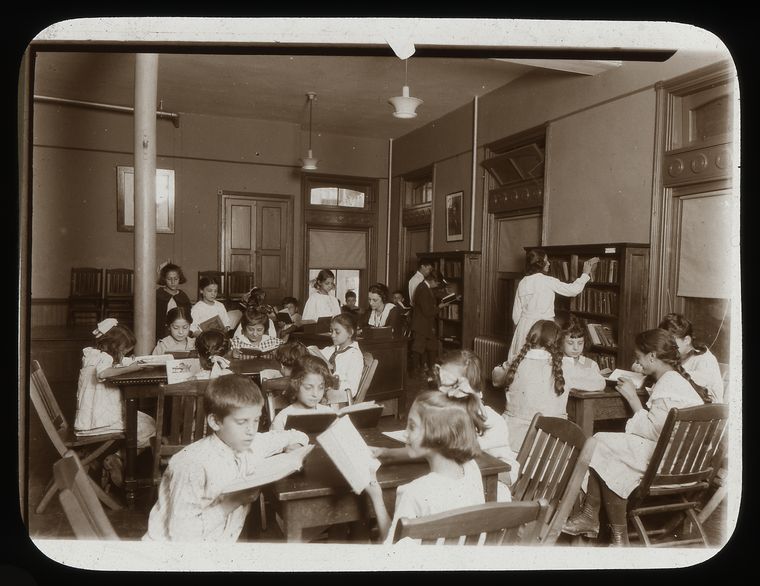Children's Literature @ NYPL
Children's Literary Salon in Retrospect: Common Core on January 4, 2014

Bird asked the panelists to discuss how their careers intersect with the Common Core.
Colleen was a teacher in New York State. She holds a master's degree in educational theatre. She helped enable teachers to take students to see Broadway productions. Now, she creates picture books and teacher guides for picture books.
Wright is the selection supervisor for the My Library NYC program. There are 500+ schools in the five boroughs of the three library systems that she helps find content for. The program has been in existence for about three years, and it provides teacher sets of books on particular subjects for their students. Over the past year, Wright has seen an increase in requests for and questions about different Leveling systems and how these measures relate to the Common Core State Standards for "text complexity."
Grabarek is a school librarian two days a week, and she works for School Library Journal. Her goal is to connect teachers and librarians with new material that could be included in the classroom. SLJ has a column called "On Common Core," and she also reviews apps.
What is Common Core?
Bird mentioned that many people may not know exactly what the Common Core consists of. She asked the panelists to give a run-down of what the Common Core state standards are.
Wright said that complex text and academic vocabulary are emphasized in the Common Core. Unfortunately, many high school graduates nowadays are not at all prepared for college-level work. One of the goals of Common Core is to create better, more critical readers.
![Aguilar Free Library, School dep't 616 5th St.,[Aguilar Free Library, School Dep'T, 616 Fifth St.], Digital ID 806009, New York Public Library Aguilar Free Library, School dep't 616 5th St.,[Aguilar Free Library, School Dep'T, 616 Fifth St.], Digital ID 806009, New York Public Library](https://images.nypl.org/?id=806009&t=w)
Colleen said that the Common Core encourages the use of comparative texts. It aims to create students who can look for varying points of view. It creates questioners, and it encourages kids to be detectives and go to different sources for information. There is a focus on who wrote the material and where it came from. She was an English teacher prior to the Internet, and she is aghast to learn that teachers now say that their students are sourcing Wikipedia.
Bird asked the panelists what they would like to see change in the future.
Wright stated that each school may have a different interpretation of how to teach to the Standards, including which classroom materials and texts that they use and how they evaluate text complexity. This is influenced by local principal control in NYC, amongst other factors.
"Leveling" Books
Bird wanted the panelists to explain "leveling."
Wright believes that people want to focus on leveling because it is concrete. Leveling measures one facet of text complexity - a text's quantitative complexity (sentence length, vocabulary, etc.) Common Core calls for three measures of text complexity - Quantitative, Qualitative, and Reader & Task. When used as a singular measure to assign a text to a grade level, Leveling (such as Lexile level) may not be accurately gauging the emotional content of text and its audience. For example, Of Mice and Men has a lexile level of 630, which falls within the recommended Lexile range for Grade 2-3.
I read that book in junior high or high school.
We do not level books in the library for many reasons including: cost (publishers need to pay to have a book leveled); variety of Leveling systems used in NYC (such as Lexile, ATOS, Fountas and Pinnell, Accelerated Reader); and incompatibility of Leveling with genres such as poetry or graphic novels. In addition, most books published in translation are not leveled, and we are attempting to get a variety of perspectives to match the cultural diversity of New York City. Wright estimates that of all the books in the library catalog, perhaps only 10% have a level.
Grabarek is not fond of leveling. The beauty of school libraries is that people can browse in them and make serendipitous discoveries.
Bird asked Colleen to discuss any challenges that she has faced regarding leveling.
Colleen is adamant that picture books are created to be read aloud. There is much pressure on kids to read independently earlier and earlier, which leads them to read easy books. Picture books are considered to be for younger kids, but they encapsulate a richness in vocabulary that should not be discounted by educators. Picture books include vocabulary that the kids may not be reading on their own, but they can ask the reader to explain the meaning of unfamiliar words.
Colleen said that picture books use a variety of literary devices, such as onomatopoeia, that can help kids appreciate language and learn much about it. She believes that the Common Core does not value picture books much, but she used to use them with highschoolers when she was a teacher.
Grabarek mentioned that there are monthly themes for the "On Common Core" column of SLJ. She also reviews children's apps in the "Touch and Go" blog. She covers picture book apps, story apps and reference apps. She only reviews a small percentage of the apps that she is aware of.
Kids' Apps
At this point, Grabarek gave a presentation of some of the apps that she has reviewed. She is particularly interested in the needs of struggling readers and kids with learning disabilities, which the Common Core has been criticized for not catering to. Audio versions of books help kids who have difficulty reading. Following are some of the apps that she presented. The presentation was very enlightening, and it includes aspects of apps (eg, ebooks) that I was not previously aware of.
- On the Road by Jack Kerouac is geared towards higher level students. The app includes the text of the book and critical commentary. It also has an interactive map of the place where the trip occurred that the book is based upon and a short video of Kerouac reading from the book. It includes letters from the publisher who greatly feared censorship.
- The Orchestra includes commentary from the performers.
- The Artifacts has interactivity about misunderstood teens who are living in a materialistic world. Midnight Feast is about a girl who escapes food shortages through her imagination. Both of these narrated apps utilize color, music and sound, and they can be used with kids in middle school through tenth grade.
- Pyramids 3D included a virtual tour inside pyramids, complete with ancient Egyptian illustrations on the inside walls.
- Wonders of Geology is one of the many science apps that are available.
- Wonders of the Universe includes two hours of video.
- Barefoot Books has produced a World Atlas app in which users can spin the globe around. It also includes a narrated piece.
- Tracking Trash, Flotsam, Jetsam, and the Science of Ocean Motion by Loree Burns
- The Adventures of Captain Underpants by Dav Pilkey
- Cinderella, a 3D Fairy Tale
- Little Red Riding Hood, told in a non-linear fashion
- A Shiver of Sharks, which kids can choose to read on their own or have narrated to them
- An alphabet app had letters that were mixed up. Kids are tasked with draggin them back to their appropriate places in the alphabet. When the child moves a letter, he or she will hear the pronunciation of it. Grabarek has a friend with a son who is using a speech therapist, and that app has been very helpful for him.
There are many reference apps and others that she did not have time to highlight in the presentation.
Bird said that she was aware of many of the print versions of the featured apps, but she did not know that there were apps for them.
FAQs about Common Core

Colleen stated that one of the biggest misconceptions about the Common Core is that it is all about nonfiction. Fiction should not be overlooked in the education of children. In elementary school, 50% of the focus is on nonfiction, and 50% on fiction. In middle school, 55% of the emphasis is on nonfiction, and 45% is on fiction. In high school, 70% of the material studied is nonfiction, and 30% is fiction.
Bird asked if what the authors know about the Common Core influences their writing.
Colleen stated that just as teachers do not appreciate teaching to the test, she does not want to write to the test. Authors need to write what is in their hearts. Any good teacher, any passionate teacher, will be able to teach books that writers create.
Wright mentioned that a silly question that she gets about the common core is "Where is the Common Core book list?" There is not one Common Core book list that kids are required to read. Students and teachers are expected to find high quality literature and use that in the classroom. Everything could be Common Core, yet nothing is Common Core. Teachers need to be able to teach the content well, and people should read to their interests. Some of the DK nonfiction books are written at a high level, yet she has seen second and third graders get through the material if they are fascinated by it. It may take them an entire summer, but it leads to a sense of accomplishment for them. We also have a fantastic Digital Gallery at the New York Public Library, and these primary source materials should not be overlooked when discussing 'common core' texts.
Colleen thinks that it is important to not discount narrative stories. Narrative fiction is a richer source of information than encyclopedic entries.
Grabarek says that she is mystified when people say that nonel of the books on their shelves are Common Core books. Libraries do not need to replace all of their books. They can use what they have, unless their material is outdated, in which case some of that material should be weeded and replaced.
Wright says that Common Core standards are geared towards helping kids to build information literacy, and one of the debates about Common Core is whether this can accurately be assessed by the current standardized testing. There is much dialog about testing, and it will be interesting to see where we are in education in ten years.
Colleen believes that teachers are empowered by Common Core to use their creativity and decide which materials to use, but the kids' reactions will be the real test as to whether the material works for them.
Audience Questions
Bird asked if the audience members had any questions.
One audience member mentioned that the teachers in the school where her third-grader studies are told by the administration which texts to teach. In fact, many of the books that are chosen are not appropriate for third graders.
Colleen and Wright reiterated that the implementation of Common Core standards vary by school and the administration. Appendix B is simply a suggested reading list.
The Common Core is nebulous and not clear-cut; people do not understand Common Core, and they find it easier to latch onto a book list to make sure that they are adhering to the standards.
Wright said that teachers are looking for assistance with finding materials that are written from different perspectives.
Colleen stated that it is important for teachers to not get pulled into the fear that they are not good teachers in this day and age. They can learn about Common Core and obtain a greater number of informational texts for their students.
Grabarek agrees that teachers' confidence has been shaken by the implementation of Common Core, and they need to regain their footing. Some secondary sources, such as Titanic: Voices from the Disaster by Deborah Hopkinson include within them primary sources, such as passages from people who directly experienced the disaster. People need to be creative in sourcing out information.
Thanks to Betsy Bird and the panelists for an interesting discussion regarding Common Core. It was great to have a variety of perspectives from an author, an acquisitions librarian and a School Library Journal editor.
Upcoming Children's Literary Salons
This Censorious World: Books for Children and Their Challenges
Saturday, February 1 at 2 p.m. at the Stephen A. Schwarzman Building
South Court Auditorium
Read E-Books with SimplyE
 With your library card, it's easier than ever to choose from more than 300,000 e-books on SimplyE, The New York Public Library's free e-reader app. Gain access to digital resources for all ages, including e-books, audiobooks, databases, and more.
With your library card, it's easier than ever to choose from more than 300,000 e-books on SimplyE, The New York Public Library's free e-reader app. Gain access to digital resources for all ages, including e-books, audiobooks, databases, and more.
If you don’t have an NYPL library card, New York State residents can apply for a digital card online or through SimplyE (available on the App Store or Google Play).
Need more help? Read our guide to using SimplyE.

